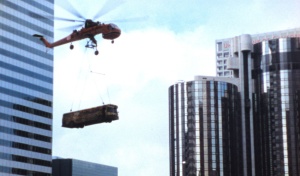A Bright and Guilty Place
Back in California and back to writing for the San Francisco Bay Guardian. First up, a quick take on Los Angeles Plays Itself:
*
Remastered and newly cleared for fair use, Thom Andersen’s incisive 2003 film essay on narrative cinema’s many representations and misrepresentations of Los Angeles plays a single night at the Castro. Andersen’s impressively choreographed montage zigzags through a vast litany of film history, submitting erotic thrillers, middlebrow Oscar bait, and avant-garde outliers to the same materialist protocol. Observing Hollywood’s tendency to falsify geography and transform landmarks of modernist geography into villainous hideouts, Andersen’s treatment of mainstream ideology is acidly funny but never condescending. To the contrary: Los Angeles Plays Itself is driven by an unshakeable faith that another kind of film — and with it another kind of world — is possible. In methodically deconstructing countless car chases and phony denouements, the native Angeleno lays groundwork for the fresh appreciation of the diverse neorealisms found in the work of directors like Kent Mackenzie (1961’s The Exiles), Nicholas Ray (1955’s Rebel Without a Cause), Fred Halsted (1972’s LA Plays Itself), Charles Burnett (1979’s Killer of Sheep), and Billy Woodberry (1984’s Bless Their Little Hearts). A true work of termite art and an impassioned argument for “a city of walkers, a cinema of walking,” Los Angeles Plays Itself is the closest thing to a cineaste’s Death and Life of Great American Cities. (2:49) Castro.
*
The film’s late-breaking copyright clearance brings this Woody Guthrie gem to mind:
This song is copyrighted in the U.S., under seal of copyright #154085, for a period of 28 years, and anybody caught singin it without our permission will be mighty good friends of ourn, cause we don’t give a darn. Publish it. Write it. Sing it. Swing to it. Yodel it. We wrote it, that’s all we wanted to do.
